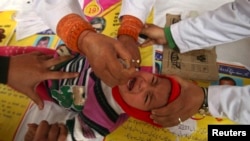On March 28th, the World Health Organization, or W-H-O, certified its South East Asia region as free of Polio. This is a remarkable achievement, given that less than five years ago, India accounted for more than half the number of polio cases worldwide.
When no new cases of the polio virus appear within a region for a period of three years, the disease is considered to be eradicated in the region. WHO certification of South East Asia means that as of March 27th, 80 percent of the global population lives in a polio-free area.
Polio is a highly infectious disease that can cause total paralysis in a matter of hours. It can strike at any age, but affects mainly children under the age of 3.
The Global Polio Eradication Initiative is one of the largest public health campaigns in history. Since 1988, U.S. Centers for Disease Control and Prevention, the WHO, UNICEF, the Bill and Melinda Gates Foundation, and Rotary International, together with scores of donor countries and foundations have been working to eradicate polio by immunizing every child under age 5.
The U.S. Agency for International Development, or USAID, also played a critical role. USAID contributed to the success of the program by identifying the importance of transient populations, coordinating cross-border efforts and communication, recognizing the need for more women vaccinators. USAID also supplied a steady flow of funding.
But the greatest accolades must go to India, a country that made a concentrated effort to drive out the disease, and succeeded in doing so, despite the enormous obstacles that hindered its vaccination campaign. Some 30 years ago, India launched a massive, 2 billion dollar effort involving a surveillance and vaccination network of nearly 2.3 million vaccinators, religious and local leaders and mobilizers, film and sports stars. The campaign was a spectacular success.
“Polio can be stopped when there is political will, quality immunization campaigns, and when we harness the determination and will of nations,” said USAID Assistant Administrator for Global Health, Dr. Ariel Pablos-Méndez.
The United States congratulates the people, political leaders and public servants of Bangladesh, Bhutan, the Democratic People’s Republic of Korea, India, Indonesia, Maldives, Myanmar, Nepal, Sri Lanka, Thailand, and Timor-Leste, on this singular achievement.
When no new cases of the polio virus appear within a region for a period of three years, the disease is considered to be eradicated in the region. WHO certification of South East Asia means that as of March 27th, 80 percent of the global population lives in a polio-free area.
Polio is a highly infectious disease that can cause total paralysis in a matter of hours. It can strike at any age, but affects mainly children under the age of 3.
The Global Polio Eradication Initiative is one of the largest public health campaigns in history. Since 1988, U.S. Centers for Disease Control and Prevention, the WHO, UNICEF, the Bill and Melinda Gates Foundation, and Rotary International, together with scores of donor countries and foundations have been working to eradicate polio by immunizing every child under age 5.
The U.S. Agency for International Development, or USAID, also played a critical role. USAID contributed to the success of the program by identifying the importance of transient populations, coordinating cross-border efforts and communication, recognizing the need for more women vaccinators. USAID also supplied a steady flow of funding.
But the greatest accolades must go to India, a country that made a concentrated effort to drive out the disease, and succeeded in doing so, despite the enormous obstacles that hindered its vaccination campaign. Some 30 years ago, India launched a massive, 2 billion dollar effort involving a surveillance and vaccination network of nearly 2.3 million vaccinators, religious and local leaders and mobilizers, film and sports stars. The campaign was a spectacular success.
“Polio can be stopped when there is political will, quality immunization campaigns, and when we harness the determination and will of nations,” said USAID Assistant Administrator for Global Health, Dr. Ariel Pablos-Méndez.
The United States congratulates the people, political leaders and public servants of Bangladesh, Bhutan, the Democratic People’s Republic of Korea, India, Indonesia, Maldives, Myanmar, Nepal, Sri Lanka, Thailand, and Timor-Leste, on this singular achievement.












